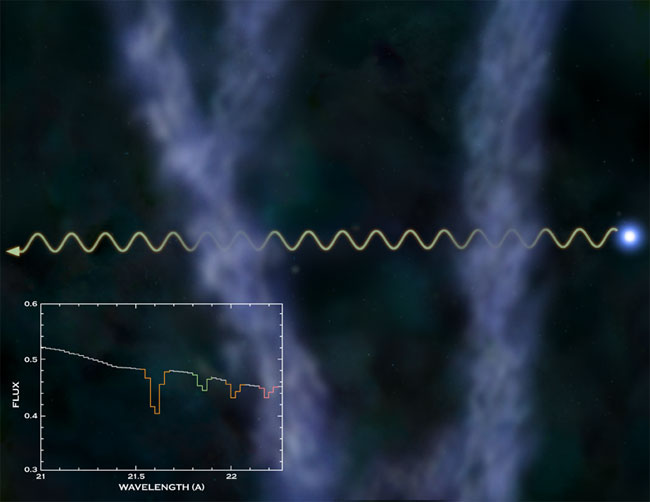From Wired:
So they found this stuff? 
Off to look for "dark energy" next.
A new study conducted with the help of the Earth-orbiting Chandra X-ray Observatory has revealed the existence of baryons in at least two giant, intergalactic clouds of super-hot gas 150 million and 380 million light-years from our planet.
The study, which appears in the Feb. 3 issue of the journal Nature, shows how certain wavelengths of X-rays emitted from a distant galaxy in the constellation Ursa Major are being absorbed by the two clouds. The absorption pattern, as detected by Chandra, is consistent with interference caused by carbon, neon, nitrogen and oxygen ions -- in other words, baryons.
When the study's authors extended the number of baryons in the two clouds to account for the volume of all the intergalactic clouds in the universe, the resulting figure equaled that of the missing matter from their computer simulations.
"Assuming that what we see is a standard portion of the universe, we extrapolated the data and derived the volume density (of baryons in all the clouds) -- and it's consistent with 50 percent," said astronomer Fabrizio Nicastro, of the Harvard-Smithsonian Center for Astrophysics and lead author of the study.
The study, which appears in the Feb. 3 issue of the journal Nature, shows how certain wavelengths of X-rays emitted from a distant galaxy in the constellation Ursa Major are being absorbed by the two clouds. The absorption pattern, as detected by Chandra, is consistent with interference caused by carbon, neon, nitrogen and oxygen ions -- in other words, baryons.
When the study's authors extended the number of baryons in the two clouds to account for the volume of all the intergalactic clouds in the universe, the resulting figure equaled that of the missing matter from their computer simulations.
"Assuming that what we see is a standard portion of the universe, we extrapolated the data and derived the volume density (of baryons in all the clouds) -- and it's consistent with 50 percent," said astronomer Fabrizio Nicastro, of the Harvard-Smithsonian Center for Astrophysics and lead author of the study.

Off to look for "dark energy" next.



Comment